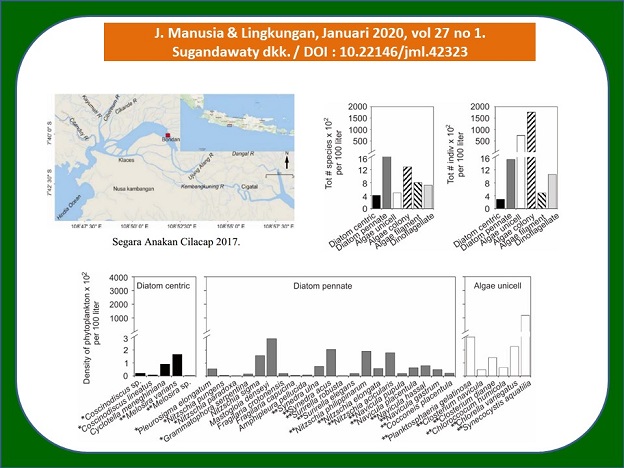
KEMELIMPAHAN FITOPLANKTON DI PERAIRAN ESTUARI PAYAU BONDAN CILACAP, JAWA TENGAH (The Abundance of Phytoplankton in the Brackish Estuary of Bondan, Cilacap, Central Java)
Tjut Sugandawaty Djohan(1*), Annisa Budyasih Ulul Azmi(2)
(1) Laboratorium Ekologi dan Konservasi Fakultas Biologi Universitas Gadjah Mada, Yogyakarta 55281.
(2) Laboratorium Ekologi dan Konservasi Fakultas Biologi Universitas Gadjah Mada, Yogyakarta 55281.
(*) Corresponding Author
Abstract
Abstrak
Kajian kemelimpahan fitoplankton di perairan estuari payau Bondan Cilacap telah dipelajari. Perairan Bondan merupakan perairan hutan bakau rusak dan dikoloni oleh semak dan liana bakau, padahal daun pohon bakau adalah sumber input nutrien utama untuk komunitas fitoplankton yang merupakan mata rantai pertama dalam jejaring makanan perairan hutan bakau. Pengambilan sampel fitoplankton dilakukan dengan pencuplikan menggunakan modifikasi van Dorn 5 L dan merupakan komposit 20 L air dengan ulangan 5 kali. Kualitas perairan yang diukur meliputi kecepatan arus dan angin, suhu air dan udara, kelembaban udara, jeluk perairan dan jeluk Secchi, intensitas cahaya, turbiditas, salinitas, pH, NH4+, NO3-, PO43-, dan SO42-. Hasil menunjukkan bahwa cacah spesies dominan adalah fungsional grup diatom, akan tetapi cacah individunya sedikit. Sebaliknya, cacah individu algae koloni melimpah tetapi cacah spesiesnya sedikit, dan terjadi peledakan Aphanocapsa pulchra, 188.260 individu per 100 L. Peledakan ini karena perairan didominasi air tawar dan kerusakan hutan bakau. Peledakan A. pulchra mengindikasikan kualitas perairan hutan bakau Bondan buruk.
Abstract
The abundance of phytoplankton in the brackish estuary of Bondan Cilacap have been studied. Bondan waters are setting in the disturbed mangrove ecosystem, which colonized by mangrove shrubs and lianas, whereas, the mangrove leaves are the main source of nutrient input for the phytoplankton community as the first link in the mangrove aquatic food web. Phytoplankton were sampled using a 5 L modification of van Dorn and a composite of 20 L of water with 5 replications. The water qualities measured include surface current, wind speed, water and air temperatures, air humidity, Secchi depth and water depth, light intensity, turbidity, salinity, pH, NH4+, NO3-, PO43-, dan SO42-. The results showed that the number of the dominant species was diatoms, but the number of the individuals was small. In contrast, the individual number of algae colony was abundant but the species number were few, and Aphanocapsa pulchra was blooming, 188,260 individuals per 100 L. This bloom was due to the waters were dominated by freshwater and the disturbed mangrove trees. The blooming of population of A. pulchra indicated that bad waters quality.
Keywords
Full Text:
PDFReferences
Bougis, P. 1976. Marine Plankton Ecology. North-Holland Publishing Company. Amsterdam..
Chaklader, M. R., A. Nahar., M. A. B. Siddik, and R. Sharker. 2015. Feeding Habits and Diet Composition of Asian Catfish Mystus vittatus (Bloch, 1794) in Shallow Water Of An Impacted Coastal Habitat. World Journal of Fish and Marine Sciences 6:551-556.
Djohan, T. S. 2007. Distribution and Abundance of Mangrove Vegetation in The Disturbed Ecosystem of Segara Anakan, Central Java. J. Manusia dan Lingkungan. 19:94-302.
Djohan, T. S. 2010. Dinamika komunitas plankton di perairan ekosistem hutan bakau Segara Anakan yang sedang berubah. J. Manusia dan Lingkungan 17:135-149.
Edmonson, W. T. 1959. Fresh Water Biology. 2nd ed. John Willey dan Sons, New York.
Mitu, N. R. and M. M. Alam. 2016. Feeding Ecology of a Bagrid Catfish, Mystus tengara (Hamilton, 1822) in the Tanore Wetland of
Rajshahi, Northwestern Bangladesh. Journal Applied Ichthyol. 32: 448–455.
Nybakken, J. W., and M. D. Bertness. 2005. Marine Biology: An Ecological Approach. Pearson-Benjamin Cummings, San Francisco.
Odum, E. P. 1971. Fundamental of Ecology. 3rd ed. WB Saunder Company. Philadelphia p 83.
O’Neil, J. M., T.W. Davis, M. Buford, and C. J. Gobler, 2012. The Rise of Harmful Cyanobacteria Blooms : The Potential Roles of Eutrophication and Climate Change. Harmful Algae 14:313-334.
Paerl, H. W. dan V. J. Paul. 2012. Climate Change: Links to Global Expansion of Harmful Cyanobacteria. Water Research 46 (5): 1349-136
Rahaman, S. M. B., L. Sarder., M. S. Rahaman., A. K. Ghosh., A. K. Biswas., S. M. S. Siraj., K. A. Huq., A. F. M. Hasanuzzaman., and S. S. Islam. 2013. Nutrient Dynamics in the Sundarbans Mangrove Estuarine System of Bangladesh Under Different Weather and Tidal Cycles. Ecologycal Proceses 2:29.
Rao, K. R. 2017. Food and Feeding Habits Of Freshwater Catfishes (Siluriformes: Bagridae: Mystus sp.). International Journal of Life-Sciences Scientific Research 3:786-791.
Sellner, K. G., D. C. Brownlee., M. H. Bundy., S. G. Brownlee, and K. R. Braun. 1993. Zooplankton Grazing in a Potomac River Cyanobacteria Bloom. Estuaries 16:859-872.
Shirota, A. 1966. The plankton of South Vietnam : freshwater and marine plankton. Over Tech Coorperation Agen, Japan.
Sutomo, H. 1982. Tidal Characteristics And Sedimentology of the Segara Anakan. p. 104-105. In E.C.F. Bird, A. Soegiarto, K.A.
Soegiarto, and N. Rosengren (eds.). Proceeding of the workshop on coastal resources management in the Cilacap region. The Indonesian Inst. of Sci. and the United Nations University. Jakarta.
Syaifullah, A. S. M., A. H. M. Kamal., M. H. Idris., A. H. Rajaee, and M. K. A. Bhuiyan. 2016. Phytoplankton in Tropical Mangrove Estuaries: Role and Interdependency. Forest Science and Technology. 12:104-113.
Shena, Y., Y. Huanga, J. Hub , P. Lia , Ch. Zhanga, L. Lia , P. Xua , J. Zhang, and X. Chen. 2019. The Nitrogen Reduction in Eutrophic Water Column Driven by Microcystis Blooms. J. Hazardous Materials 385:121578.
Article Metrics
Refbacks
- There are currently no refbacks.
Copyright (c) 2020 Jurnal Manusia dan Lingkungan

This work is licensed under a Creative Commons Attribution-ShareAlike 4.0 International License.







